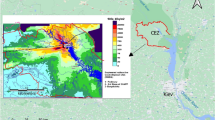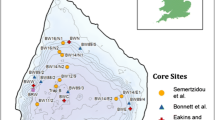Abstract
Recent identification of elevated excess 210Pb (≤302.6 mBq L−1) and 137Cs (≤111.3 mBq L−1) activity in drinking water wells up to 20 m depth indicates some transport of airborne radionuclide fallout beyond soils in the Shaker Village catchment, Maine. Estimated airborne mass loading 210Pbex fluxes of about 0.9 mBq m−3, canvass this headwater catchment and may be sufficient to pose risks to unprotected shallow wells. Inventories of 210Pbex and 137Cs in pond sediments indicate maximum median activities of 943 mBq g−1 and 40.0 mBq g−1, respectively. Calculated 210Pbex fluxes in the catchment soils range from 0.62–0.78 Bq cm−2 year−1 and yield a mean residence time of near 140 years. Measured 137Cs activity up to 51.1 mBq g−1 occurs in sediments at least to 5 m depth. Assumed particle transport in groundwater with apparent 85Kr ages less than 5 years BP (2005) may explain the correlation between these particle-reactive radionuclides and elevated activity in some drinking water wells.











Similar content being viewed by others
References
Appleby PG, Nolan PJ, Gifford DW, Godfrey MJ, Oldfield F, Anderson NJ, Battarbee RW (1986) 210Pb dating by low gamma background counting. Hydrobiologia 141:21–27
Appleby PG, Oldfield F (1992) Application of lead-210 to sedimentation studies. In: Ivanovich M, Harmon RS (eds) Uranium-series Disequilibrium. Clarendon Press, Oxford, pp 731–778
Beven K, Germann P (1982) Macropores and water flow in soil. Water Resour Res 18:1311–1325
Campbell BL, Loughran RJ, Elliot GL (1982) Cesium-137 as an indicator of geomorphic processes in a drainage basin. J Aust Geogr Stud 20:1–49
Cember H (1992) Introduction to health physics. McGraw Hill, New York
Chesser K, Rodgers BE, Wickliffe JK, Gaschak S, Chizhevsky I, Phillips CJ, Baker RJ (2001) Accumulation of 137cesium and 90strontium from abiotic and biotic sources in rodents at Chernobyl, Ukraine. Environ Toxic Chem 20:1927–1935
Doering C, Akber R, Heijnis H (2006) Vertical distributions of 210Pb excess, 7Be and 137Cs in selected grass covered soils in Southeast Queensland, Australia. J Environ Radioact 87:135–147
Domenico PA, Schwartz FW (1990) Physical and chemical hydrogeology. Wiley, New York
Easthouse KB, Mulder J, Christophersen N, Seip HM (1992) Dissolved organic carbon fractions in soil and stream water during variable hydrological conditions at Birkenes, southern Norway. Water Resour Res 28:1585–1596
Fisenne IM (1994) Lead-210 in animal and human bone: a new analytical method. Environ Int 20:627–632
Hess CT, Weiffenbach CV, Norton SA (1983) Environmental radon and cancer correlations in Maine. Health Phys 45:339–348
Ho EC, Measday DF (2005) A simple model for describing the concentration of 212Pb in the atmosphere. J Environ Radioact 78:289–309
Holtzman RB (1963) Lead-210 (RaD) and polonium-210 (RaF) in potable waters in Illinois. In: Adams JS, Lowder WM (eds) The natural radiation environment. University of Chicago Press, Chicago, pp 227–237
Hussey AM (1988) Lithotectonic stratigraphy, deformation, plutonism, and metamorphism, greater Casco Bay Region, Southeastern Maine. In: Marvinney R (ed) Studies in maine geology, v 1. Maine Geologic Survey, Augusta, pp 17–34
Jaworowski Z (1969) Radioactive lead in the environment and in the human body. Atomic Energy Rev 7:3–45
Klanminder J, Binder R, Emteryd O, Appleby PG, Grip H (2006) Estimating the mean residence time of lead in the organic horizon of boreal soils using 210-lead, stable lead and a soil chronosequence. Biogeochem 78:31–49
Koterba MT, Wilde FD, Lapham WW (1996) Updates to ground-water data-collection protocols and procedures for the national water-quality assessment program: collection and documentation of water-quality samples and related data. US Geological Survey Open-File Report 95–399
Krishnaswami S, Lal D, Martin JM, Meybeck M (1971) Geochronology of lake sediments. Earth Planet Sci Lett 11:407–414
Kung KJ (1990) Preferential flow in a sandy vadose zone: 2 Mechanism and implications. Geoderma 46:59–71
Malcolm RL (1985) Geochemistry of stream fulvic and humic substances. In: Aiken GR (ed) Humic substances in soil, sediment, and water. Wiley-Interscience, New York, pp 181–209
Marcazzan GM, Caprioli E, Valli G, Veechi R (2003) Temporal variation of 212Pb concentration in outdoor air of Milan and comparison with 214Bi. J Environ Radioact 65:77–90
Mayer LM, Schick LL, Hardy KR, Wagal R, McCarthy J (2004) Organic matter in small mesopores in sediments and soils. Geochim Cosmochim Acta 68:3863–3872
McDowell IM, Hunt JR, Sitar N (1986) Particle transport through porous media. Water Resour Res 22:1901–1921
Moore WS (1984) Radium isotope measurements using germanium detectors. Nucl Instr Meth Phys Res 223:407–411
Murray AS, Marten R, Johnston A, Martin P (2005) Analysis for naturally occurring radionuclides in environmental concentrations by gamma spectrometry. J Radioanal Nucl Chem 115:263–288
National Weather Service (2005) Annual meteorological data, Gray Station, Maine. http://www.weather.gov/view/national
Orton GJ, Reading HG (1993) Variability of deltaic processes in terms of sediment supply, with particular emphasis on grain size. Sedimentology 40:475–512
Porstendorfer J, Zock C, Reineking A (2000) Aerosol size distribution of radon progeny in outdoor air. J Environ Radioact 51:37–48
Ritchie JC, McHenry JR (1990) Application of radioactive fallout cesium-137 for measuring erosion and sediment accumulation rates and patterns: a review. J EnvironQual 19:215–233
Robbins JA (1978) Geochemical and geophysical applications of radioactive lead. In: Nriagu JO (ed) Biogeochemistry of lead in the environment. Elsevier, Amsterdam, pp 285–393
Robbins JA (ed) (1984) Geochronology of recent deposits. Chem Geol 44:1–348
Robbins JA, Eadie BJ (1991) Seasonal cycling of trace elements 137Cs, 7Be, 239 + 240Pu in Lake Michigan. J Geophys Res 96:17081–17104
Salers JE, Hornberger GN (1996) The role of colloidal kaolinite in the transport of cesium through laboratory sand columns. Water Resourc Res 32:33–41
Shanklin DE, Sidle WC, Ferguson ME (1995) Micro-purge low flow sampling of uranium-contaminated ground water at the Fernald Environmental Management Project. Ground Water Monitor Rev Summer 15:168–176
Sheets RW, Lawrence AE (1999) Temporal dynamics of airborne lead-210 in Missouri (USA): implications for geochronological methods. Environ Geol 38:343–348
Sidle WC (2006) Apparent 85Kr ages of groundwater within the Royal watershed, Maine, USA. J Environ Radioact 91:113–127
Sidle WC, Li P (2007) Submersible pump impacts on Pb constituents in residential wells. Environ Geochem Health. doi:10.1007/s10653-007-9090-4
Smith BM, Grune WN, Higgins FB, Terrill JG (1961) Natural radioactivity in ground water supplies in Maine and New Hampshire. J Amer Water Works Assoc 53:75–88
Smith GW, Hunter LE (1989) Late Wisconsinan deglaciation of coastal Maine. In: Marvinney R (ed) Studies in Maine Geology, v 6. Maine Geologic Survey, Augusta, pp 13–32
Tessier A, Campbell PC, Bisson M (1979) Evaluation of the APDC-MIBK extraction method for the atomic absorption analysis of trace metals in river water. Int J Environ Anal Chem 7:41–54
Turekian KK, Benninger LK, Dion ED (1983) Be-7 and Pb-210 total deposition fluxes at New Haven, Connecticut and at Bermuda. J Geophys Res 88:5411–5415
USEPA (2005) United States Environmental Protection Agency, National Primary Drinking Water Regulations. http://www.epa.gov/safewater/standards/standards.html
Veechi R, Marcazzan G, Valli G (2005) Seasonal variation of 210Pb activity concentration in outdoor air of Milan (Italy). J Environ Radioact 82:251–266
Wahlgren MA, Nelson DM, Chase EM (1978) Sediment trap methodology. US Department of Energy, Radiological and Environmental Research Division, Rept ANL-78-65, Part III Argonne National Laboratory, pp 77–79
Weddle TK (1997) Surficial geology of the Gray 7.5-minute quadrangle, Androscoggin and Cumberland counties, Maine. Maine Geologic Survey, OF Report 97-73, 1-10, with plate OF-97–58
Williams JS, Tepper DH, Tolman AL, Thompson WB (1987) Hydrogeology and Water Quality of Significant sand and Gravel Aquifers in Parts of Androscoggin, Cumberland, Cumberland, Oxford, and York Counties, Maine. Maine Geologic Survey OF Report 87-1a
Zapecza OS, Szabo Z (1986) Natural radioactivity in groundwater-a review. In Moody DW, Carr J, Chase EB, Paulsen RW (eds) National Water Summary-1986. US Geological Survey Water Supply Pap 2325
Acknowledgments
Without the full and gracious cooperation of homeowners and businesses in the region, this research would not be possible. Special thanks are given to the field crews through the years to complete an uninterrupted sampling record through all seasons. The cooperation of Maine Public Health is appreciated. Thanks to the USEPA Isotope Hydrology Laboratory (Cincinnati); D. Andrews, Dartmouth College; B. Craig, Oak Ridge National Laboratory; and R. Kolmar, Groundwater Research, Oxford, Ohio. Any opinions expressed in this paper are those of the author and do not, necessarily, reflect the official positions and policies of the USEPA. Any mention of products or trade names does not constitute recommendation by the USEPA.
Author information
Authors and Affiliations
Corresponding author
Rights and permissions
About this article
Cite this article
Sidle, W. Vulnerability of headwater catchment resources to incidences of 210Pb excess and 137Cs radionuclide fallout. Environ Geol 57, 377–388 (2009). https://doi.org/10.1007/s00254-008-1306-0
Received:
Accepted:
Published:
Issue Date:
DOI: https://doi.org/10.1007/s00254-008-1306-0




